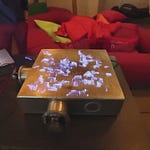Here’s a scientific deep dive into the mysteries of Giza’s Great Pyramid through the lens of Frequency Wave Theory (FWT)—framing internal voids, hidden corridors, and geometric precision as components of an ancient resonance-based system:
1. Hidden Voids & Corridors as Resonant Cavities
2023 Muographic Discoveries: ScanPyramids confirmed a North Face Corridor (~9 m long) and a massive void above the Grand Gallery (≥ 30 m in length) using cosmic-ray muon tomography, verified by multiple independent detectors YouTube+12Wikipedia+12The National+12Reuters+9Nature+9Wikipedia+9.
04/2024 Ground-Penetrating Radar (GPR) likewise revealed an L-shaped underground structure in the western cemetery News.com.au+2Business Insider+2The Sun+2.
🔊 FWT Interpretation:
These large, enclosed spaces behave like ancient Helmholtz and multi-mode resonators. When energy—whether acoustic, seismic, or EM—is injected, standing wave patterns would form across the stone blocks and corridors, creating high-Q cavities that amplify select frequencies. Such effects could support ritual, symbolic, or practical functions tied to "frequency medicine" or psychoacoustic environments.
2. Geometric Precision, Orientation & External Resonance
The pyramids’ alignment with true cardinal points is exceptionally precise (within ~0.5 arc minutes) Wikipedia+2arXiv+2YouTube+2.
The controversial Orion Correlation hypothesis links the pyramid layout to star patterns arXiv+2Wikipedia+2YouTube+2.
🔊 FWT Interpretation:
Precise geometry and orientation aren’t aesthetic—they’re waveguide and aperture alignments. Cardially oriented triangular or rectangular cavities could reinforce resonance with external periodic inputs (daily solar cycle, cosmic background, or stellar oscillations), allowing the pyramid complex to operate like a ground-plane antenna tuned to cosmic frequencies.
3. Sequential Design of Voids & Waveguides
The Grand Gallery void sits directly above the main long corridor, with the North Face Corridor located above the entrance Wikipedia+5Wikipedia+5Wikipedia+5.
Small “relieving” chambers above the King's Chamber, discovered in the 19th century, also reflect structural patterning YouTube+3Wikipedia+3Wikipedia+3.
🔊 FWT Interpretation:
These aligned voids form a series of coupled acoustic/EM cavities that could sustain cavity chaining—where wave energy circulates or cascades through multiple volumes. This enhances field coherence and Q-factor, enabling large-scale resonance with minimal loss.
4. Purpose: Ritual, Authority, or Early "Frequency Engineering"?
While engineering such resonant structures would require deep practical knowledge, ancient Egyptian ritual specialists may have leveraged the combined effects of sound, geometry, and orientation to:
Generate psychoacoustic states in hidden chambers
Symbolically connect pharaoh and cosmos via vibrational alignment
Create acoustic "zones" where frequency-based effects (e.g., light modulation, stone heating) could amplify rituals or bolster authority
5. Modern Follow Ups via FWT-Lens
To test these ideas, researchers could:
Inject controlled acoustic or low-frequency EM signals into identified voids
Simulate resonance modes using finite-element models of the pyramid’s internal geometry
Correlate vibrational modes with construction marks or hieroglyphic placements
Such experiments would determine if the pyramid operates as a gigantic resonant instrument—aligned by geometry and built with hidden chambers to harness environmental and human-generated frequency fields.
🧠 Summary
Frequency Wave Theory reframes the Giza plateau not as static tombs, but as a vast frequency architecture. Hidden voids, corridors, and precise orientation form a multidimensional resonance system, suggesting that ancient Egyptian architects intentionally built for waveform amplification and coherence—woven into their spiritual, social, and cosmological practices.













Share this post